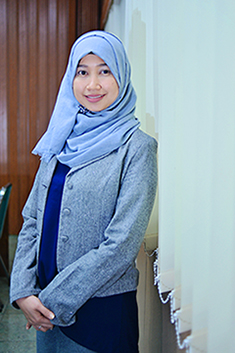Optimasi Metode KCKT untuk Penetapan Kadar 4-Isobutilasetofenon dan 2-(4-Isobutirilfenil) Asam Propanoat dalam Tablet Ibuprofen
Downloads
Pendahuluan: Ibuprofen (IBP) banyak digunakan sebagai obat anti piretik dan pereda nyeri, obat ini sensitif terhadap oksidasi dan suhu. Cemaran IBP yang keberadaannya dalam tablet harus memenuhi syarat uji batas adalah 4-isobutilasetofenon (IBP RC C) dan 2-(4-isobutirilfenil) asam propanoat (IBP RC J). Variasi matriks tablet seringkali membuat prosedur standar untuk analisis cemaran perlu dioptimasi karena dapat menyebabkan kinerja kromatografi yang tidak memenuhi syarat kompendia. Tujuan: Penelitian ini bertujuan untuk memperoleh kolom dan kondisi operasional KCKT yang selektif, efisien dan memenuhi persyaratan kompendia untuk pengujian IBP dan cemarannya. Metode: Penelitian ini dirancang untuk membandingkan kinerja kromatografi (resolusi, faktor ikutan dan jumlah lempeng teoritis) beberapa kolom KCKT C18 yang sesuai persyaratan United States Pharmacopoeia (USP) untuk penetapan cemaran organik dalam tablet ibuprofen. Instrumen KCKT yang digunakan adalah Shimadzu Prominence dengan detektor Photo Diode Array (PDA). Kondisi analisis optimum yang diperoleh diaplikasikan untuk analisis 3 macam sediaan tablet IBP. Hasil: Kondisi optimum diperoleh melalui kolom C18-C 4,6 x 250 mm, 5 µm, menggunakan fase gerak larutan asam kloroasetat 1% pH 3,0 : asetonitril (45:55, v/v), laju alir 1,5 mL/menit, suhu kolom ambient, detektor PDA 254 nm, volume injeksi 10 µL dengan waktu analisis 11 menit. Diperoleh puncak-puncak yang simetris dengan kinerja kromatografi yang memenuhi persyaratan USP. Kesimpulan: Metode yang telah dioptimasi berhasil diaplikasikan pada 3 sediaan tablet yang beredar di pasaran dan dapat digunakan untuk pengujian rutin dalam rangka pengawasan kualitas produk obat tablet ibuprofen.
Anderson, N. G. (2012). Final Product Form and Impurities. In: Anderson NG (ed.). Practical Process Research and Development; 365–395. Jacksonville: Elsevier.
Castell, J. V., Gomez-L., M. J., Miranda, M. A. & Morera, I. M. (1987). Photolytic degradation of Ibuprofen. Toxicity of the Isolated Photoproducts on Fibroblast and Erythrocytes. Photochemistry and Photobiology; 46; 991–996.
Caviglioli, G., Valeria, P., Brunella, P., Sergio, C., Attilia, A. & Gaetano, B. (2002). Identification of Degradation Products of Ibuprofen Arising from Oxidative and Thermal Treatments. Journal of Pharmaceutical and Biomedical Analysis; 30; 499–509.
Cory, W. C., Harris, C. & Martinez, S. (2010). Accelerated Degradation of Ibuprofen in Tablets. Pharmaceutical Development and Technology; 15; 636–643.
Farmakope Indonesia. (2014). Tablet Ibuprofen (Edisi 5). Jakarta: Departemen Kesehatan RI.
Farmer, S., Anderson, P., Burns, P. & Velagaleti, R. (2002). Forced Degradation of Ibuprofen in Bulk Drug and Tablets: Determination of Specificity, Selectivity, and the Stability-Indicating Nature of the USP Ibuprofen Assay Method. Pharmaceutical Technology North America; 26; 28–42.
Hersh, E. V & Dionne, R. A. (2017). Nonopioid Analgesics. In: Hersh EV, Dionne RA (ed.). Pharmacology and Therapeutics for Dentistry; 257–275. St. Louis: Elsevier.
Huidobro, A. L., Rupérez, F. J. & Barbas, C. (2006). Tandem Column for the Simultaneous Determination of Arginine, Ibuprofen and Related Impurities by Liquid Chromatography. Journal of Chromatography A; 1119; 238–245.
Jahan, M. S., Islam, M. J., Begum, R., Kayesh, R. & Rahman, A. (2014). A Study of Method Development, Validation, and Forced Degradation for Simultaneous Quantification of Paracetamol and Ibuprofen in Pharmaceutical Dosage form by RP-HPLC Method. Analytical Chemistry Insights; 9; 75–81.
Kazakevich, Y. & LoBrutto, R. (2007). Stationary Phases. In: Kazakevich Y, Lobrutto R (ed.). HPLC for Pharmaceutical Scientists; 75–132. Hoboken: John Wiley & Sons, Inc.
Lembke, P., Günter, H., Cabrera, K., Brunner, W. & Muller, E. (2001). Handbook of Analytical Techniques. In: Gunzler H. & Williams A. (ed.). Handbook of Analytical Techniques; 261–326. Weinheim: Wiley-VCH.
Maggio, R. M., Vignaduzzo, S. E. & Kaufman, T. S. (2013). Practical and Regulatory Considerations for Stability-indicating Methods for the Assay of Bulk Drugs and Drug Formulations. TrAC Trends in Analytical Chemistry; 49; 57–70.
Massad, L., Anderson, P., Ward, J., Burns, P. & Velagaleti, R. (2002). Validation of Changes to the USP Assay Method for Ibuprofen Tablets: Extraction and Filtration Techniques. Pharmaceutical Technology; 26; 90–100.
Melo, S. R. D. O., Homem-De-Mello, M., Silveira, D. & Simeoni, L. A. (2014). Advice on Degradation Products in Pharmaceuticals: A Toxicological Evaluation. PDA Journal of Pharmaceutical Science and Technology; 68; 221–238.
Moldoveanu, S. C. & David, V. (2017). RP-HPLC Analytical Columns. In: Moldoveanu SC, David V (eds.). Selection of the HPLC Method in Chemical Analysis; 279–328. Amsterdam: Elsevier.
Nageswara, R. R. & Nagaraju, V. (2003). An Overview of the Recent Trends in Development of HPLC Methods for Determination of Impurities in Drugs. Journal of Pharmaceutical and Biomedical Analysis; 33; 335–377.
Persson. S., K. & í…ström, O. (1998). Separation of Ibuprofen, Codeine Phosphate, Their Degradation Products and Impurities by Capillary Electrophoresis II. Validation. Journal of Chromatography A; 826; 95–102.
Skoog, D. A., West, D. M., Holler F. J. & Crouch, S. R. (2014). Fundamentals of Analytical Chemistry. Belmont-USA: Mary Finch.
United States Pharmacopeia. (2018). Ibuprofen Tablets Monographs (USP 41-NF). Rockville: United States Pharmacopeia.
United States Pharmacopeia. (2019). Impurities in Drug Substances and Drugs Products (USP 42-NF. Rockville: United States Pharmacopeia.
1. The copyright of this journal belongs to the Editorial Board and Journal Manager with the author's knowledge, while the moral right of the publication belong to the author.
2. The formal legal aspect of journal publication accessibility refers to the Creative Commons Attribution-Non-Commercial-Share Alike (CC BY-NC-SA), which implies that the publication can be used for non-commercial purposes in its original form.
3. Every publication (print/electronic) is open access for educational, research, and library purposes. In addition to the objectives mentioned above, the editorial board is not responsible for copyright infringement


.jpg)















